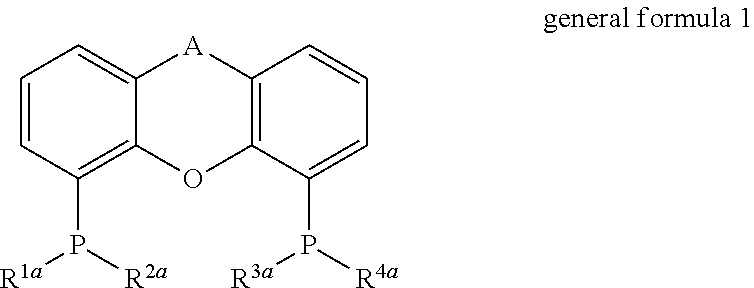Process for homogeneously catalyzed, highly selective direct amination of primary alcohols with ammonia to primary amines with a high volume ratio of liquid phase to gas phase and/or high pressures
a technology of ammonia and primary alcohol, which is applied in the preparation of amino compounds, organic chemistry, carboxylic acid amides, etc., can solve the problems of high temperature, time-consuming and costly two-stage procedure for isolation of carbonyl compounds, and heterogeneous catalysis gas phase processes
- Summary
- Abstract
- Description
- Claims
- Application Information
AI Technical Summary
Benefits of technology
Problems solved by technology
Method used
Image
Examples
example 1
Direct Single-Stage Amination of 1-hexanol by Means of Ammonia Over a Homogeneous Ruthenium Catalyst at a Low VliqVgas (Comparative Example, not According to the Invention, VliqVgas=0.05)
[0068]Under an argon atmosphere, 1.022 g (10 mmol) of 1-hexanol, 0.006 g (0.01 mmol) of carbonylchlorohydrido[4,5-(di-i-propylphosphinomethylacridino)ruthenium(II)] as catalyst, 1 ml of water and 2 ml of dioxane as solvent were placed in a 90 ml Fischer-Porter reactor. The vessel was closed and pressurized with 20 bar of argon and depressurized three times. Ammonia was then introduced into the autoclave up to a pressure of 7.5 bar (overall Vliq / Vgas=0.05), the reactor was heated to 135° C. and maintained at this temperature for 30 hours. After cooling to room temperature, the reactor was opened and the reaction product was analysed by gas chromatography. 1-Hexylamine is obtained with a yield of 79.7% (99% conversion).
example 2
Direct Single-Stage Amination of Furfuryl Alcohol by Means of Ammonia Over a Homogeneous Ruthenium Catalyst at a Low VliqVgas ((Comparative Example, not According to the Invention, VliqVgas=0.05)
[0069]Under an argon atmosphere, 0.098 g (1 mmol) of furfuryl alcohol, 0.0128 g (0.02 mmol) of dodecacarbonyltriruthenium and 0.0204 g (0.06 mmol) of 2-(dicyclohexylphosphanyl)-1-phenyl-1-H-pyrrol as catalyst and 1 ml of 2-methyl-2-butanol as solvent were placed in a 50 ml steel tube. The vessel was closed and pressurized with 20 bar of argon and depressurized three times. The vessel was then cooled by means of dry ice and 0.6 g (1 ml, 35.3 mmol) of ammonia was condensed in (overall Vliq / Vgas=0.05), the reactor was heated to 150° C. and maintained at this temperature for 20 hours. After cooling to room temperature, the reactor was opened, the solvent was removed on a rotary evaporator and the residue was dissolved in methanol and analysed by gas chromatography. Furfurylamine is obtained in a...
example 3
Direct Single-Stage Amination of Tripropylene Glycol by Means of Ammonia Over a Homogeneous Ruthenium Catalyst at High Pressure and a High VliqVgas (According to the Invention, VliqVgas=0.3)
[0070]Under an argon atmosphere, 0.961 g (5 mmol) of tripropylene glycol, 0.0305 g (0.05 mmol) of carbonylchlorohydrido[4,5-(di-i-propylphosphinomethylacridino)ruthenium(II)] as catalyst and 25 ml of 2-methyl-2-butanol as solvent were placed in the glass liner of a 100 ml Hastelloy autoclave. The autoclave was closed, pressurized with 20 bar of argon and depressurized three times and again pressurized with 15 bar of argon. 2 g (2.95 ml; 117 mmol) of liquid ammonia were then introduced into the autoclave (overall Vliq / Vgas=0.3). The reaction mixture was stirred (600 rpm) at room temperature for 10 minutes, subsequently heated to an internal temperature of 170° C. while stirring and maintained at this temperature for 48 hours, with a pressure of 45 bar being established. After cooling to room tempe...
PUM
| Property | Measurement | Unit |
|---|---|---|
| Temperature | aaaaa | aaaaa |
| Pressure | aaaaa | aaaaa |
| Pressure | aaaaa | aaaaa |
Abstract
Description
Claims
Application Information
 Login to View More
Login to View More - R&D
- Intellectual Property
- Life Sciences
- Materials
- Tech Scout
- Unparalleled Data Quality
- Higher Quality Content
- 60% Fewer Hallucinations
Browse by: Latest US Patents, China's latest patents, Technical Efficacy Thesaurus, Application Domain, Technology Topic, Popular Technical Reports.
© 2025 PatSnap. All rights reserved.Legal|Privacy policy|Modern Slavery Act Transparency Statement|Sitemap|About US| Contact US: help@patsnap.com



